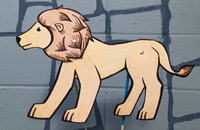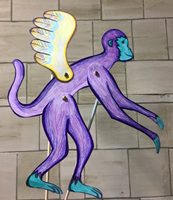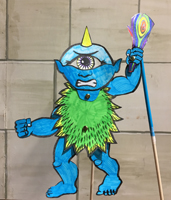Shadow Play: The Columbia Marionette Theatre’s Puppet Residency
Conducted by: Artistic Director Lyon Hill and two other puppeteers
Appropriate for: Grades 1 – 3
Capacity: up to 4 groups of no more than 24 students each
Duration: three 50 minute sessions (usually over 3 days, but can be consolidated to one day)
Cost: Customized to each instance, base rate $975
Goal: To introduce students to the art of shadow puppetry. Each child will make a shadow puppet and learn to perform with it.
We supply: Lights, shadow screen, all materials for construction.
Please provide: A room that can be darkened, ample workspace for participants to construct, a place to store materials for the duration of the residency
Session 1: Introduction to puppetry: We demonstrate the four most popular types of puppetry: Hand puppets, rod puppets, marionettes, and shadow puppets. We focus on shadow puppetry, giving a brief history of the art form. We talk about different light sources, shadows, silhouettes, opacity and transparency using examples. We perform a skit from Jack (or Jackie) and the Beanstalk which requires a volunteer, but no preparation. It is performed on an overhead projector with one tall weed or plant. Students are shown examples of the type of puppet they will make and select one of 12 templates. Each student cuts out the pieces for their puppet and stores them in a labelled bag.
Session 2: Construction of puppet: Each child resumes work on their puppet. We pause at each step and demonstrate. Once pieces are cut out, joints are added with fasteners and hole punches. Control rods are added with straws and dowels. Finally, each child can customize their puppet with crayons and markers. At any point, they can bring their puppet behind the screen to see its shadow.
Session 3: Practice and perform: There are usually a few things left to construct at the start. We demonstrate the best way to stand, to enter the screen, exit, and use your voice while performing. We also talk about how to be a good audience. A random selection of three students comes behind the screen. We come up with a brief scenario and act it out on the spot. After a few groups have gone, a student may wish to narrate for the other performers. Everyone gets at least one opportunity to be behind the screen. We end with a recap and explaining how the students can create their own shadow puppet stages and puppets with simple materials.








